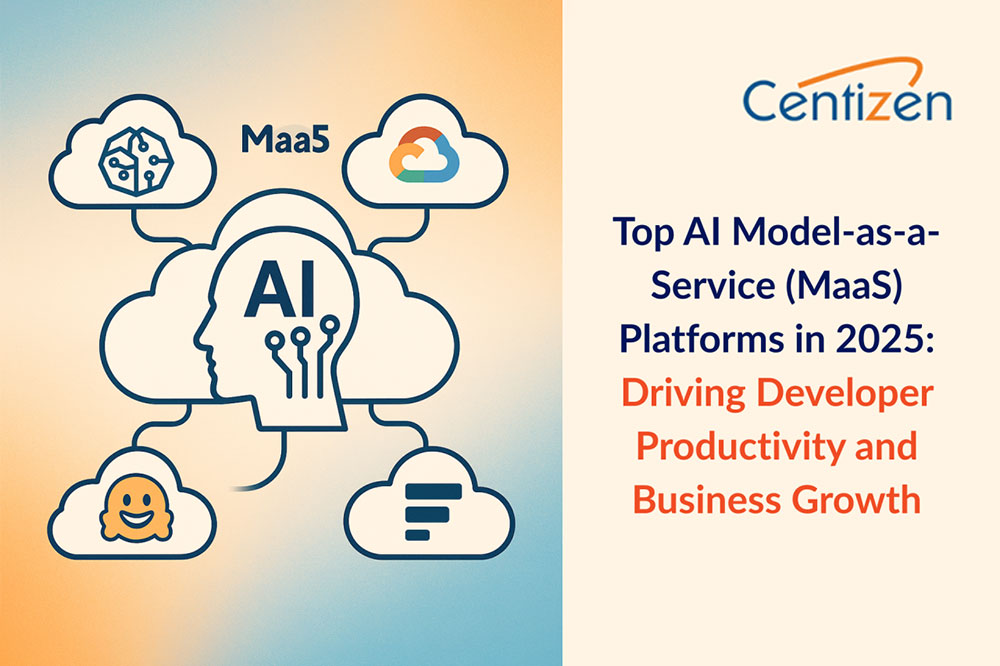Top AI Model-as-a-Service (MaaS) Platforms in 2025: Driving Developer Productivity and Business Growth

The Model-as-a-Service (MaaS) ecosystem is transforming how developers and enterprises leverage artificial intelligence in 2025. By providing pre-built AI and machine learning models via the cloud—along with integrated deployment, scaling, and billing capabilities—MaaS enables faster innovation, reduced infrastructure costs, and improved accessibility for teams of all sizes.
In this guide, we’ll explore the definition, top platforms, benefits, challenges, monetization models, governance needs, and future trends shaping MaaS in 2025.
What is model-as-a-service (MaaS)?
Model-as-a-Service is a cloud-based AI delivery model where developers access ready-to-use machine learning models without the need to manage hosting, scaling, or version control.
Key characteristics include:
- Cloud-based AI models for development, deployment, and lifecycle management.
- API access for easy integration into applications.
- Monitoring and usage-based billing to track performance and costs.
Leading MaaS platforms in 2025
Here are some of the most popular MaaS providers reshaping the AI landscape:
- AWS sagemaker – Fully managed ML infrastructure for building, training, and deploying models with minimal server management.
- Google vertex AI – Streamlines data ingestion, model training, and predictions within the Google Cloud ecosystem.
- Hugging face inference API – Grants access to thousands of open-source AI models for quick prototyping.
- Replicate – Runs open-source AI models in the cloud without the need for local setup.
Benefits of MaaS for developers
- Reduced complexity – Offloads server, scaling, and versioning tasks.
- Fast onboarding – API keys, SDKs, and sample apps enable model usage in minutes.
- Scalable access – Pre-trained models and sandboxes speed up experimentation.
- Cost efficiency – Pay-as-you-go pricing avoids upfront infrastructure investments.
Challenges developers face with MaaS
Despite its advantages, MaaS introduces new challenges:
- Platform-specific APIs – Unique interfaces create learning curves.
- Billing variability – Diverse models (per-token, per-request) complicate budgeting.
- Observability gaps – Limited telemetry integration impacts monitoring.
- Migration hurdles – Proprietary formats make switching providers difficult.
Strategies to overcome friction
- Choose platforms with transparent pricing tools and standardized telemetry exports.
- Use community-driven documentation and reusable modules for faster integration.
- Test in realistic sandbox environments before production deployment.
Revenue and monetization models
MaaS platforms support flexible monetization:
- Revenue sharing – Similar to app stores, with fees or subscription tiers.
- Hybrid pricing – Free base models with premium fine-tuned versions.
- Creator benefits – Global reach and simplified billing, albeit with less control over pricing.
Governance, trust, and compliance
For enterprise adoption, MaaS platforms must prioritize:
- Transparency – Model lineage, bias reports, and performance metrics.
- Observability – End-to-end prediction tracing integrated with monitoring tools.
- Data privacy – Clear policies on usage, tenant isolation, and opt-outs.
- Compliance – Certifications and governance features to meet industry standards.
Avoiding vendor lock-in
To maintain flexibility, businesses should:
- Prefer platforms supporting exportable models and open inference formats.
- Use standardized runtimes for cross-cloud compatibility.
- Ensure portability in billing, telemetry, and data migration.
Future outlook for MaaS in 2025
- Wider adoption of standardized AI formats.
- Enhanced cost management and governance tools.
- More equitable revenue sharing between creators and platforms.
- Expansion into industry-specific AI solutions for healthcare, finance, and manufacturing.
Action plan for businesses
- Evaluate platforms based on operational needs, not just model accuracy.
- Run pilot projects covering deployment, monitoring, and rollback.
- Leverage community resources for faster adoption.
- Review SLA and data policies for long-term sustainability.
Final thoughts
Model-as-a-Service in 2025 is enabling faster AI adoption, reducing technical barriers, and opening new revenue streams for developers and enterprises. However, the real value lies in choosing the right platform, ensuring data governance, and avoiding vendor lock-in to maintain strategic flexibility.
By adopting MaaS strategically, businesses can accelerate innovation while managing risks in an increasingly AI-driven economy.
Our services:
- Staffing: Contract, contract-to-hire, direct hire, remote global hiring, SOW projects, and managed services.
- Remote hiring: Hire full-time IT professionals from our India-based talent network.
- Custom software development: Web/Mobile Development, UI/UX Design, QA & Automation, API Integration, DevOps, and Product Development.
Our products:
- ZenBasket: A customizable ecommerce platform.
- Zenyo payroll: Automated payroll processing for India.
- Zenyo workforce: Streamlined HR and productivity tools.
Services
Send Us Email
contact@centizen.com
Centizen
A Leading Staffing, Custom Software and SaaS Product Development company founded in 2003. We offer a wide range of scalable, innovative IT Staffing and Software Development Solutions.
Call Us
India: +91 63807-80156
USA & Canada: +1 (971) 420-1700
Send Us Email
contact@centizen.com
Centizen
A Leading Staffing, Custom Software and SaaS Product Development company founded in 2003. We offer a wide range of scalable, innovative IT Staffing and Software Development Solutions.
Call Us
India: +91 63807-80156
USA & Canada: +1 (971) 420-1700
Send Us Email
contact@centizen.com






